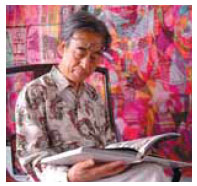 |
|
Mu has started to paint on silk since 1980s.
|
That's why Mu made his mind to rejuvenate the art of silk painting. He has since restored a whole set of traditional skills and credited it with extraordinary atheistic values due to his pioneering moves, like painting on folded layers of silk.
Such explorations have made his works more appealing: colors are fuller and strokes are stronger.
 |
|
A snapshot of Mu.
|
And Mu never confines his painting to one particular school. A brief look at his works shows the realist gongbi technique, the freely expressive xieyi style, exaggerative portraits that feature folk art and some changes in shades characteristic of Impressionist works.
That is part of Mu's endeavor to improve silk painting's vitality and its ability to impress the audience. Knowing there is much room to expand the color scheme of Chinese painting, he has been exploring up and down in hopes of bringing into full play color-related emotions, rhythm and symbols in his works.
Examples include Celebrating the Spring Festival, the hues of which are evocative of happy, lucky celebrations unique in Chinese culture.
Another example is The Silk Road. Featuring cold tones, it offers an ethereal depiction of elegant and graceful Buddha and his music gods that are recurrent figures in ancient Chinese murals.
He is also introducing new skills to create patterns, including restructuring and crisscrossing everyday forms, adopting them to pursue what Chinese painters did thousands of years ago.
We Recommend:
